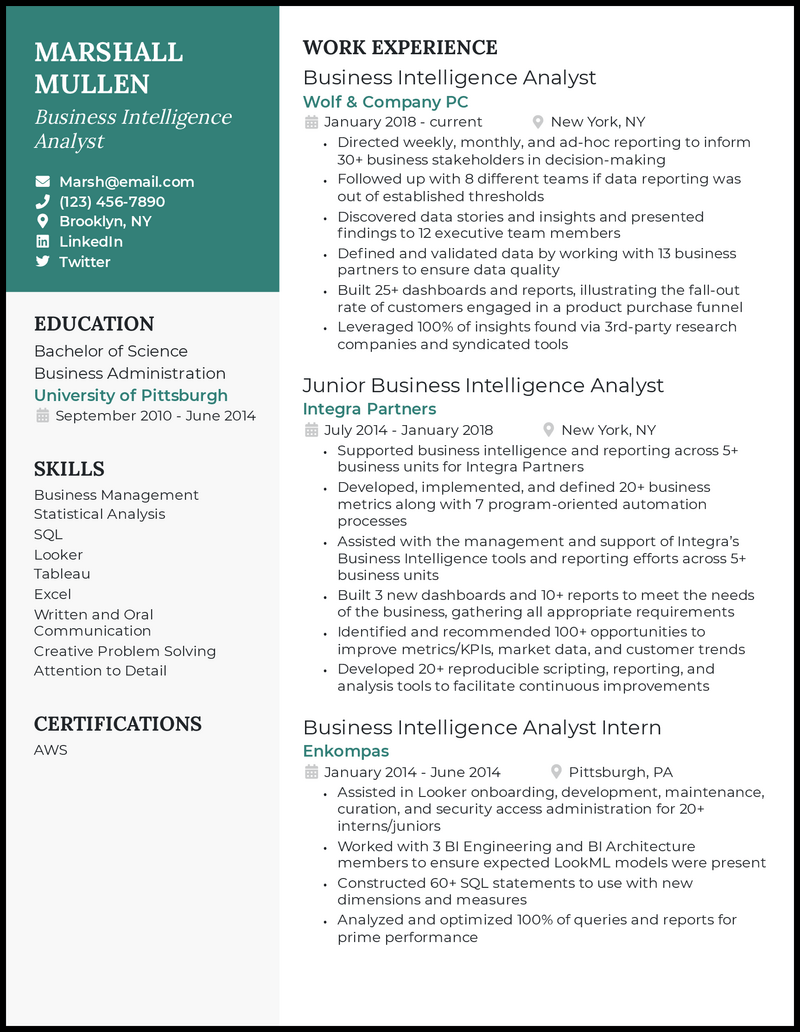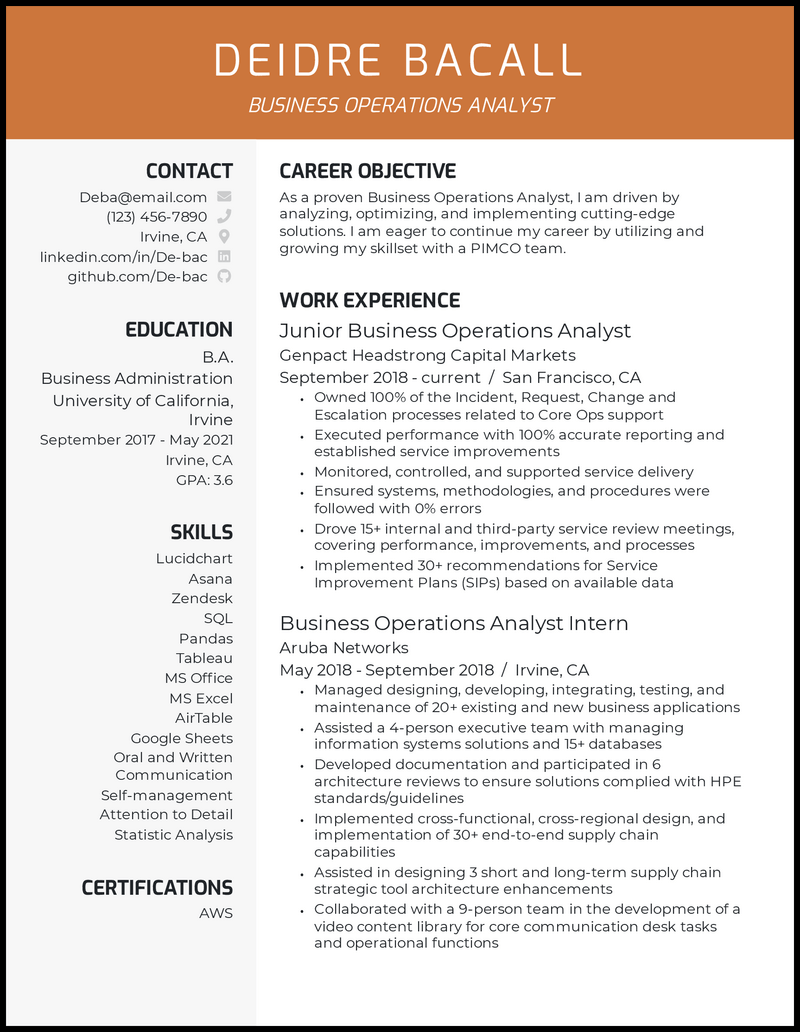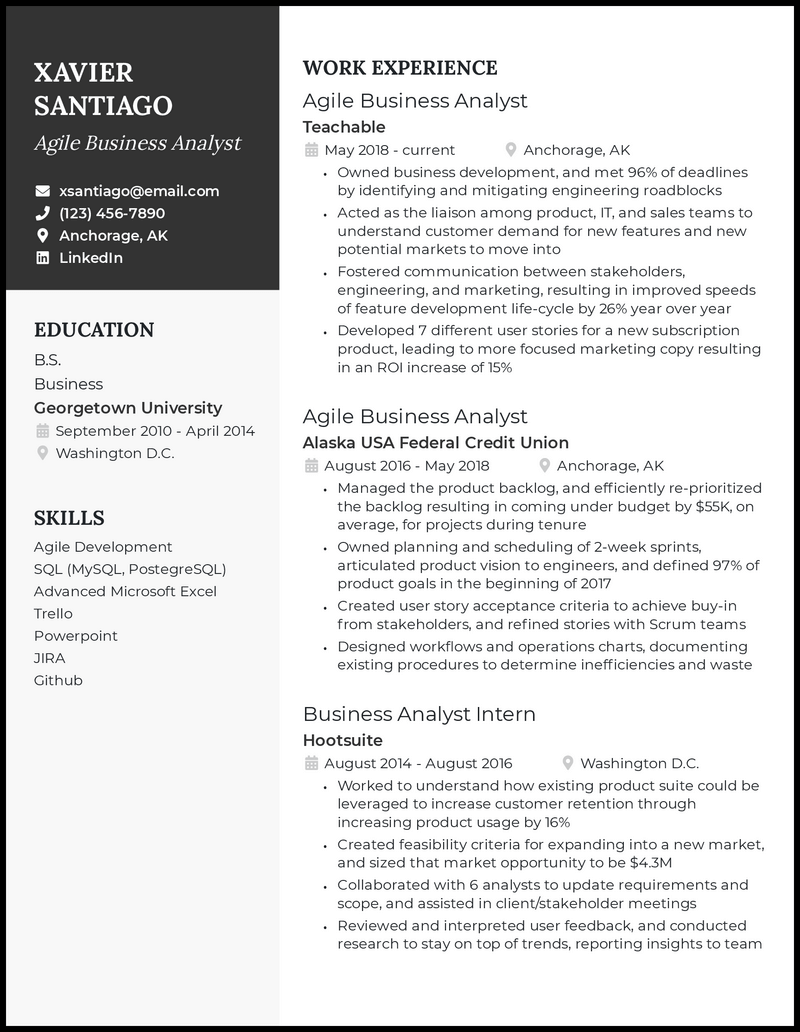Building a business analyst resume or cover letter means demonstrating to employers that you can effectively present key metrics that inform profitable business decisions. Simply mentioning that you cleaned up raw data is never a good idea.
So, buckle up your business seatbelts and brush up on your Power BI skills, because this guide will cover:
- ↪ 27 Best Business Analyst Resume Examples
- ↪ A Comprehensive Guide on Creating a Business Resume
- ↪ The Top Must-Haves in a Business Analyst Resume
Why this resume works
- Your business analyst resume works best by illustrating a blending of a well-defined career path and a data-driven resume outline. Therefore, you’re on track to success if you’ve started your business analyst career by pursuing a bachelor’s degree in business.
View more business analyst resumes>
Why this resume works
- Having a well-established career trajectory of College Graduate → BIA Intern → BIA Junior → BIA provides a proven and well-documented history of growth and improvement over time.
See more business intelligence analyst resumes >
Why this resume works
- There are hundreds of different technologies that can be utilized to achieve the mission of a business systems analyst. It’s paramount to research the job market to see which skill specifics apply to you: Looker, Tableau, and SQL rank highly in this specialized job market.
View more system analyst resumes >
Why this resume works
- The second source takes a general look at desired job titles in a specific geographic location. After evaluating the market’s desired skill requisites, emphasize specific bullet points with KPIs to complement and enhance your credibility.
See more senior business analyst resumes >
Why this resume works
- You need to show how those skills are applied practically and how they can drive meaningful business results. Include specific projects where you utilized Salesforce Agile Accelerator or Informatica Cloud to streamline business processes, demonstrating your hands-on experience.
See more Salesforce business analyst resumes >
Why this resume works
- Deploy your ServiceNow business analyst resume’s career objective to paint a picture of a passionate hard worker who will inspire the team to perform and achieve goals. Merge that passion with the willingness to unleash your expertise and experience to help the potential employer be ahead of the competition.
Why this resume works
- The best way to prove that you’re actually a pro at the skills you list is to show those same skills in action in your work experience section. As you write your bullet points, look for ways to integrate these skills naturally.
See more IT business analyst resumes >
Why this resume works
- If you can demonstrate that you’re already up to speed on the skills and systems required to succeed, recruiters will take notice. For example, highlight your Certified Professional in Healthcare Information and Management Systems (CPHIMS) credential.
Why this resume works
- Add a direct link to your LinkedIn profile in the resume’s header section. Be careful, though; a run-of-the-mill profile can make the hiring manager think twice about bringing you on board, so optimize yours accordingly.
Why this resume works
- Highlight times you’ve taken the initiative to streamline systems to showcase your knack for spotting bottlenecks—and fixing them. Besides, a cover letter writer is a fantastic tool to discuss relevant personal projects to bridge your gap in professional experience.
Why this resume works
- Spotlight how you’ve used (and will use) Appian, Celonis, or Tableau to enhance business operations. This approach gives your resume a practical edge, proving your tech proficiency and ability to leverage it in real-world scenarios.
Why this resume works
- Your operations analyst resume should focus on one obvious thing: operational analysis, primarily. Reinforce as much operational, analytical data as you can by including improvement/enhancement KPIs to showcase the overall impact on the company’s bottom line.
See more operations analyst resumes >
Why this resume works
- When you’re applying for a junior-level role, maybe you lack relevant work experience. Adding a career objective helps an employer connect the dots between your past performance and the position you want.
Why this resume works
- Having tools like IBM Watson Natural Language Understanding and Microsoft Azure ML will create a strong impression on the employer and give the idea that your RPA business analyst resume is well beyond the average candidate.
Why this resume works
- For a solid banking business analyst resume, let the experience section be a ledger of your business acumen and sharp problem-solving expertise. That way, it could be easier to catapult your piece to the top of the pile, garnering a healthy interest from the hiring manager seeking a candidate with your finesse.
Why this resume works
- In the world of business analysis, leveraging stacks of data to find solutions is the name of the game. What can give you a headstart and get recruiters to pick you over someone with more experience is showcasing your ability to cut the Gordian knot and grow business.
Why this resume works
- Include a phrase like “analyzed SQL queries for performance optimization, cutting query execution times by 49% and boosting database performance for over 1,084 users”. It’s the kind of evidence that proves your prowess and translates your technical achievements into clear business value.
Why this resume works
- Showcase your ability to build new systems with a prominent skills section. For example, highlighting SQL on your technical business analyst resume proves that you can create databases for the enterprise.
Why this resume works
- Build credibility by starting with a firm foundation via a bachelor’s degree in business and then completing that foundation with a lengthy internship. Once one to two years of experience has been gained, including multiple KPIs, it will demonstrate a history of driving value.
See more Agile business analyst resumes >
Why this resume works
- Showcase your risk management skills: recognizing and prioritizing risks, assessing impact, and developing effective strategies. Then add results such as, “Invested in redundant backup infrastructure that slashed data loss risk by 98%”.
Why this resume works
- Put your outstanding skills and impressive capability to drive business decisions in the limelight and have recruiters instantly know you’re the right fit for their business. For instance, mention that you used SAP ERP for supply chain management and cut procurement costs by 16%.
Why this resume works
- Two things should outshine everything else in your finance business analyst resume: accurate data reporting and reliable financial trend and pattern forecasting. In that regard, achievements such as reducing errors by 21% and 14% improvement in forecasting accuracy deserve to be highlighted.
Why this resume works
- If looking to create an outstanding Jira business analyst resume, zero in on using numbers to set the bar high for other applicants and showcase a much-desired data-driven mindset.
Why this resume works
- A bachelor’s degree in business is an extremely versatile tool that can be leveraged in many ways. If your resume includes an excellent GPA, it will ensure the reader’s eye will see a 4-year degree has been completed.
See more entry-level business analyst resumes >
Why this resume works
- Emphasize how you’ve applied your knowledge of AEM to own impactful projects in an enterprise. Clear examples will build your credibility and improve your chances of landing an interview.
Why this resume works
- This is a great time to add bullet points like “realizing $1.5M+ in cost savings through optimized vendor negotiations”. Don’t forget to add metrics for other finances such as cash flow and profit margins, too!
Why this resume works
- Don’t even think about using jargon in your e-commerce business analyst resume. In a bid to show that you’re at the top of your game, you might alienate the hiring manager and ruin your interview chances.
Related resume guides
How to Write a Business Analyst Resume

While writing your resume, you must focus on including quantified impacts that show how your insights brought actual business value. Also, make sure that you’re doing each section justice by adding adequate information.
Overall, just keep your experiences concise, measurable, and results-driven. The section below will take you through:
- Best tips for quantifying your past analytical experiences.
- Formatting techniques that will get you past any ATS system.
- Ideas for including projects if you’re new to the field.

What you sohould know about BA roles
My favorite part of being a business analyst was that no two days were the same. One day I might be deep in the weeds of complex SQL queries and the next I’d be talking to customers to understand how they used our products.
This wide scope of responsibilities made the job exciting and challenging. No two business analysts have the same job so it can be really hard to know what to put on your resume to appease hiring managers at different companies.
I’ve hired business analysts, I’ve applied to jobs as a business analyst, and I’ve reviewed thousands of business analyst resumes at this point in my career. Fundamentally, you have to make the case that you’re capable of having a meaningful impact on the business you’re applying to.
This holds true whether you’re an entry-level business analyst looking for your first full-time role or you’re a senior business analyst looking for a promotion to management. Make your case that you’ll have a meaningful, positive impact in the role you’re applying for.
In short, here are the ways to make sure you accomplish that:
- Kick off your resume with a resume summary if you’re eyeing a senior role or a career objective if you’re a beginner
- Showcase a solid and relevant work experience
- Use the skills section to demonstrate your hard and soft skills
- Use resume examples that have worked for other business analysts to get their dream jobs

How to showcase your business analyst skills
Compared to other tech roles, the scope of hard skills that business analysts need to have are relatively consistent across companies.
While the kind of analysis that a business analyst does from role to role varies drastically, the underlying tenets of the role remain the same. A business data analyst takes in data and leverages their insights to improve business processes or operations.
Whether that happens through forecasting, pricing, reporting, or statistical analysis, the toolbox that a successful BA needs to have is well defined.
First, you need to be able to prep data for analysis. More often than not, companies store their data in relational databases. So this means you need to know SQL to pull and clean that data.
If the quantity of data that a company has is significantly smaller, you might get all the data you need to analyze right in (usually very sloppy) Excel workbooks.
After the data is prepped you need to do your analysis. That can come in the form of interactive models (in which case you’ll likely be using Excel) or you might need to do a more sophisticated analysis in Python or R.
Finally, you need a way to present your findings. Again, sometimes this can just be visualizations in Excel (Excel is the true business analyst MVP), sometimes it can be through data visualization in a BI tool like Tableau or Looker, and sometimes it might be through a presentation in PowerPoint.
Skills to include on your business analyst resume
- SQL (MySQL, PostgreSQL, SQLite, SQL Server)
- Excel, Google Sheets
- Powerpoint, Google Slides
- Tableau, Looker, Chartio
- Python, R
- Salesforce, Netsuite, Hubspot, Pipedrive
- A/B testing, linear regression, logistic regression
Notice a theme here? Only include hard skills in your skills section. Think of it this way: if you were reviewing a resume and someone listed they were a “team player” in their skills section, would that tell you anything about their qualifications?
No, it wouldn’t. Soft skills are best demonstrated in an interview. Listing them on a resume just doesn’t add any value.
The other thing you have to consider is that there are two stages of resume review:
- Companies use an Applicant Tracking System (ATS) to automatically filter out resumes based on certain keywords used in your bullet points, skills, and LinkedIn headline.
- The hiring manager or HR person in charge of screening for the role will look at your resume.
When companies use keyword filters, they only ever screen for hard skills. So soft skills won’t help you get past phase 1. And like I said before, just listing soft skills on your resume won’t convince the hiring manager you actually possess those skills.
How can you balance your skills section to satisfy both the ATS and the hiring manager? First, don’t include a long laundry list of skills. This is a big red flag to the hiring manager even if it will help you get past the ATS.
For example, there is no reason you would include Python, R, Matlab, and SAS on your resume. When it comes to your skills section you want to avoid coming across as a jack of all trades and a master of none.
It’s much better to demonstrate expertise in a handful of skills than a passing understanding of 15-20 skills.
When you’re debating whether or not you should include a given skill on your resume just ask yourself if you’d be comfortable being asked questions about that skill in an interview.
Lying on your resume is one of the only guaranteed ways to make sure you’ll never be able to get a job at a company at some point in the future. For me, I also wouldn’t be able to handle the anxiety of potentially being exposed for a resume lie in an interview. It’s not worth it!

How to get your business analyst resume format right
Formatting your resume properly may matter more than you think. For any given BA role a hiring manager reviews 100+ resumes. To that end, they’re looking for a reason to say “no” to any given application they review.
Formatting your resume incorrectly is a quick way to get placed into the “no” pile. Your goal with formatting your business analyst resume is to make the job of the hiring manager as easy as possible.
Put yourself in their shoes. Given the same exact experience for two candidates would you be more likely to approve the resume that extends to 5 pages or the resume that concisely makes the case for their qualifications?
Here are the high-level formatting tips you should keep in mind for your business analyst resume:
- Keep it to one page. If it’s longer than a page, the hiring manager will likely only skim it.
- Unless you’re customizing your business analyst resume summary, don’t include it on your resume. It’ll just take up space.
- If you’re a senior business analyst, keep your education section really short. If you’re an entry-level business analyst, include relevant classes you took in school that make you qualified for the role.
- Don’t get too creative with your formatting. Your resume needs to be machine-readable so don’t include any images or charts.
- Include links to any relevant work, projects, or write-ups you have.
- This can be your LinkedIn, Github, personal blog, publications, etc.. Anything that makes the case about your skills as a business analyst.
Since your goal is to keep your resume to one page, every inch of real estate is valuable. If you’re a senior business analyst this means you need to keep your education small to allow for more room to talk about your work experience.
Conversely, as an entry-level business analyst, you need to make the case that you’re qualified to be a BA without much (or any) work experience. To do that, you should include relevant math/statistics/economics/programming classes you took in school.
Business analyst education section: senior vs entry-level
- Senior business analyst
- Only include the essentials. Your school, the degree you earned, and your major.
- You don’t need to include your GPA.
- Entry-level business analyst
- You need the essentials (school, degree, major)
- Include relevant classes you took that make you qualified to be a BA
- This can be classes in mathematics, statistics, economics, programming, business classes, etc.
- Include your GPA if it’s above 3.2.
What certifications strengthen a business analyst resume?
The best certifications to add to a business analyst resume are:
- PBA — Project Management Institute
- ECBA — International Institute of Business Analysis
- Agile Analysis Certification — International Institute of Business Analysis
- Certified ScrumMaster — Scrum Alliance

Business analyst resume summary or objective
Spoiler alert, most (90%+) of business analyst job applicants don’t need a resume objective or resume summary.
Why? The overwhelming majority of them are too long, too generic, or don’t provide any new information about a candidate’s qualifications for the BA role they’re applying for. Because of this, a lot of hiring managers have been conditioned to ignore this section (especially when it’s too long).
If you’re going to include a resume objective, make sure it actually adds value to your resume. Here are some ways you can do that:
- Talk about why you’re specifically interested in working as a business analyst at the company you’re applying to.
- Customize your resume objective for each job you apply to; this means carefully reading each of those business analyst job descriptions!
- Read what you’ve written. Is it just generic, meaningless buzzwords? If so, then it’s better not to include it.
- Keep it to two lines or less. Longer than that, the hiring manager likely won’t read it.
To clarify this point here are some samples of good and bad business analyst resume objectives and summaries.
If you’re looking for more inspiration we’ve compiled over 100 resume objective examples you can use.
WRONG – meaningless buzzword bingo
Looking to leverage my analytical skillset to turn messy data into actionable insights for a mission-driven company
WRONG – way too long
Business analyst with 7+ years of making meaningful impacts with my analyses. Comfortable working cross-functionally with teams ranging from product to engineering to leadership. Experienced with turning vague product requests into business requirements that are implemented in a streamlined manner. To date, in my career, I’ve driven $3.7M of value through my analyses and recommendations.
RIGHT – demonstrating a specific interest in the company
As a former small business owner, I’m excited about the prospect of leveraging my experience leading data-driven product recommendations to further Stripe’s mission of making payments accessible to businesses of all sizes.

How to quantify impact on your BA resume
The goal of a business analyst is to leverage data to make recommendations that have a demonstrable impact on a business or product. More than anything you need to make it clear on your resume that you have this capability.
How can you do that? By showing that you’ve done it in the past! You need to estimate the impact of the projects you’ve worked on.
One of the toughest challenges of being a business analyst is trying to quantify the seemingly unquantifiable. How can you estimate the potential revenue impact of a feature that hasn’t been launched? How can you estimate the impact of a pricing change on customer churn?
These are challenges that business analysts have to deal with in their day-to-day. By estimating the quantitative impact of your past work you’re clearly demonstrating you have a knack for logical, numerical reasoning that is essential to succeed as a business analyst.
The impact of your projects doesn’t just have to be stated in terms of revenue impact. Here are some other ways you can go about it.
Ways to quantify your work as a business analyst
- Improved customer conversion rate
- Example: Leveraging Google Analytics and Excel identified a gap in the product funnel and made a recommendation that improved customer conversion rate by 10%
- Saved manual reporting time
- Example: Streamlined and automated a key business report in Tableau that saved the team 10 hours of reporting each week.
- Reduced costs
- Example: Using SQL and Excel recommended that we end our contracts with our worst-performing vendors resulting in a cost savings of $100,000 annually.
- Built data visualizations to help executives
- Example: Built data visualizations in Excel to demonstrate the efficacy of our sales operations and marketing resulting in the close of a $1.3M Series A.
- Improved customer retention
- Example: Determined through analysis in Python that emailing customers who had been inactive for 7 days resulted in a retention improvement of 7 basis points.
- Improved customer satisfaction
- Example: Using SQL and Excel, identified common complaints amongst new customers leading to changes that improved new customer satisfaction by 14%.
When it comes to demonstrating the impact of your work it’s important you focus on the most important metrics relevant for a given project. Being able to determine the success vs failure criteria of an experiment is pivotal to being a good business analyst.
Just to hammer the point home one last time I want you to compare these two work experiences. Now, this is the same business analyst talking about their experience in a certain role in two different ways.
Which do you think is more effective in convincing the hiring manager they’re a highly qualified business analyst?
WRONG – vague description of work experience
Insurance Company
August 2014 – August 2016, Washington DC
Business Analyst
- Identified procedural areas of improvement through customer data to help improve the profitability of a nationwide retention program
- Using Python, SQL, and Excel developed and owned the reporting for a nationwide retention program
RIGHT – specific projects with demonstrable impact
Insurance Company
August 2014 – August 2016, Washington DC
Business Analyst
- Identified procedural areas of improvement through customer data using SQL to help improve the profitability of a nationwide retention program by 7%
- Using Python, SQL, and Excel developed and owned the reporting for a nationwide retention program, saving ~100 hours of labor each month

Project ideas for entry-level business analysts
If you’re an entry-level business analyst, I know what you’re thinking: “Stephen, this whole section is focused on work experience but what if I don’t have work experience as a business analyst?” (P.S. I don’t actually know what you’re thinking, I just needed a decent segue)
The beauty of being a business analyst is that you don’t need work experience to demonstrate the skills needed to succeed in a full-time role!
Fundamentally a business analyst needs to ask a question, gather data to answer that question, and analyze the data to provide a convincing answer to that question.
You can do that on your own! Talking about a project you worked on to scratch your own itch demonstrates to a hiring manager that you have the desire and skills to succeed as a business analyst.
Get creative! Have you had a question you’ve long wondered about? Think of some data you can gather and do a write-up about your findings.
To get your creative juices flowing here are some questions I’ve thought a lot about and how I might go about answering them.
Sample business analyst projects for your resume
- Have the New York Mets (my favorite team) had bad injury luck?
- I would gather data around the value of each player on the roster in terms of their output over the last 10 years and the number of games they missed each season. I’d then compare this to other teams in the league and do a write-up.
- Are entry-level business analyst jobs really entry-level?
- I’d look at some of the most popular job boards for business analyst job descriptions. I’d manually gather attributes about each of the job descriptions and do a write-up.
- What is the most valuable skill for a business analyst to have?
- Look at salary data and job descriptions of business analyst roles across the country. I’d control for confounding factors like years of experience and try to tease out what individual technical skill most correlated with a higher salary.
- Do people actually like Oscar movies?
- I’d look at the box office and public reviews of movies nominated for the “best picture” Oscar as far back as I can get reliable data and do an analysis trying to answer this question.
- Do west coast ultra-runners perform better than east coast ultra-runners? (ultra-running is a hobby of mine)
- I would get public data around the top 200 ultra marathons each year going back as far as I can get data. I’d then compare the hometowns of top performers to see if accessibility to trails and good weather correlate with performance on race day.

How to write a great business analyst resume
No matter if you’re a senior business analyst or an entry business analyst looking for your first role, the north star of your resume should be to demonstrate to the hiring manager you’ll have a meaningful impact on their business!
- Only include hard skills in your “skills” section. If you would not feel comfortable being interviewed about a given skill, don’t include it.
- Keep your resume to one page and triple-check for spelling and grammar errors. More likely than not you should not include a resume objective or summary.
- Demonstrate your numerical reasoning skills by quantifying the impact of your past work as a business analyst. If you’re looking for your first BA role, include projects you’ve worked on your resume.
It took me 66 applications before I landed my first business analyst role in 2010. I know looking for a new job is generally miserable, so try to keep your head high.
You got this! I’m rooting for you. If there is anything I can do to help you land your next business analyst role, please don’t hesitate to reach out.

Key takeaways
- Include BA certifications directly mentioned in the job listing
- Choose specific action words depending on your analytical experience
- Always quantify how your analytical work impacted business decisions
- Include the top industry in-demand skills like SQL and Tableau
- Follow the bwest formatting practices to ensure your business analyst resume passes any ATS system
Business Analyst Resume FAQs

A technical business analyst should highlight roles in developing software solutions, bridging collaboration gaps between IT and business teams, and enhancing systems through data-driven insights. Emphasize skills in requirements and compliance, system analysis, technical documentation, and collaboration with cross-functional teams to bring robust, scalable, innovative solutions to life.
Make it results-driven, concise, and tailored to the job. It should include your title and level of experience, list key business analysis skills, demonstrate quantifiable achievements, and conclude with your career mission and vision. Keep it between 2 and 3 lines and focus on the value you bring to the employer.
Here’s an example of a powerful resume summary:
“Detail-oriented principal business analyst with 10+ years of experience driving process improvements and delivering data-backed insights for Fortune 500 clients. Spearheaded a CRM optimization project that cut customer churn by 18%. Skilled in SQL, Tableau, and Agile methodologies. Passionate about leveraging analytics to shape future-ready business strategies.
A business analyst’s resume should show how you analyze data, streamline processes, and implement innovative solutions that drive measurable business outcomes. Use verbs like “led,” “analyzed,” “optimized,” and “solved” to reflect how you applied business analytics to solve problems with a forward-thinking approach.
Your business analyst resume should be one page if you’re at the entry to the mid-level stage to ensure clarity and impact. For senior-level professionals with extensive experience and accomplishments, going beyond one page is acceptable—just ensure every line adds value.
































